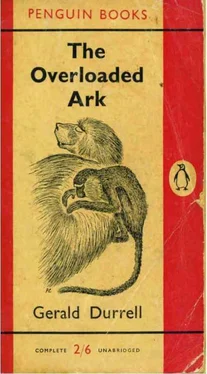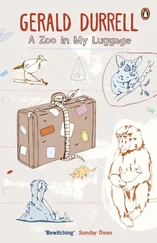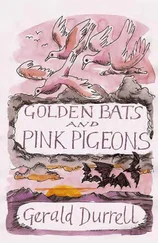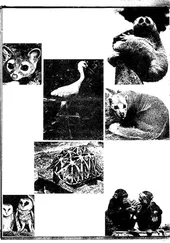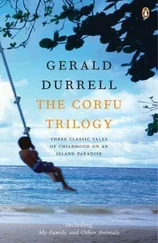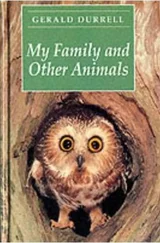While I changed out of my wet clothes Elias went down to the village and roused the Carpenter from his bed, and then we set to work to fashion a cage fine enough to house this rarity. The sky was a pale green flecked with the red of coming dawn as we drove in the last nail, then I tenderly undid the sack and gently shook the Giant Water Shrew into his new home. He sat there for a minute, wiffling his mass of whiskers, and then slid swiftly through the hole into his darkened bedroom. I could hear him rustle round once or twice among the dry banana leaves inside, and then came a deep sigh and silence. The Water Shrew was taking his capture very quietly. I did not emulate him: the entire staff was marshalled to go down to the river and catch me fish, frogs, water- snakes, and crabs; and two carriers were hastily dispatched into Mamfe to procure an empty drum to act as a swimming pool for the Shrew. While all this was taking place I kept creeping back to his cage every five minutes to see if there was any sign of life. Soon I had a basket full of crabs, six frogs, ten fish, and a rather anaemic-looking water-snake. Arranging all these within easy reach I started to feed the Shrew.
After my banging on his bedroom door for a bit he condescended to come out into the open part of his cage, and as the sun was now up I had my first real good look at him. He was nearly two feet long, of which more than half was composed of his tail. This strong muscular member was not flattened from top to bottom as an otter’s is, but from side to side like a tadpole’s. The hair on it was so short and sleek that it looked as though the whole tail was made out of polished black leather. All the top half of the animal was black, but paws, belly, throat and chest were pure white. The body was small and dumpy, and the head curiously flattened. Its muzzle and parts of its cheeks near the nose were swollen and enlarged, and from this bristled a forest of stiff white whiskers. From on top, the Shrew’s head looked not unlike the head of a hammer. Its feet were small and neat, and its eyes were microscopic pin-points of glinting jet buried in the fur.
I opened the door of its cage and threw the snake in. The Shrew approached it, preceded by its quivering mass of whisken. The snake made a slight movement, the Shrew sniffed, and then backed rapidly away, hissing furiously in the same way I had noticed before. I removed the snake and tried a frog, with the same results. Then I tried a fish which, according to the earliest reports on this animal, is its only food, and the Shrew refused that as well. He was rapidly getting bored with these proceedings, and was casting hopeful looks at his bedroom, when I threw in a large crab. He approached, sniffed, and then, before the crab had time to get his pincers ready, the Shrew had overturned it and delivered a sharp bite through the underside, almost cutting the crab in two with one bite. Having done this, he then settled down and finished off his meal with great rapidity, scrunching loudly and quivering his whiskers. Within half an hour he had polished off four crabs, and so his feeding problem was settled for the moment.
The next day the carriers returned from Mamfe staggering under the weight of a huge petrol drum. This had to be cut in half, lengthways, all the rust scraped out, and any trace of oil removed by boiling water in it for twenty-four hours. Then the Shrew was removed from his cage while a sliding door was fitted in the bottom. The whole cage was then placed on top of the half petrol drum; thus, by opening and closing the sliding door I could let the Shrew in and out of his private bathing pool. He enjoyed this immensely, and every night made the most resounding hisses and grunts in its hollow interior while in pursuit of his crab dinner. I found that the water fouled very quickly, so that it had to be changed three times a day, much to the water-boy’s annoyance.
The Shrew, now adequately housed and with access to water, settled down very well and proceeded to demolish twenty or twenty-five crabs a day, which proved lucrative for the small boys who collected them.
The Giant Water Shrew is perhaps one of the most interesting animals to be found in West Africa. It is, to all intents and purposes, a living prehistoric creature, a warm-blooded, breathing, biting fossil. Potomagale velox, as it is called scientifically, was first discovered by Du Chaillu, the gentleman who brought such discredit upon himself by his lurid accounts of gorilla-hunting in the eighteen- hundreds. Owing to his penchant for colouring his material with the aid of a fertile imagination, Du Chaillu’s every statement or discovery became suspect in the eyes of zoologists. However, in the case of Potomagale he seems to have contented himself with repeating just what the natives told him, and so in his original description he endows it with habits and a choice of food which appear to be completely wrong.
The animal has no relatives in the world, except a small mouse-like creature called Geogale, which lives in Madagascar. As it is unknown in fossil form it is impossible to say exactly how old an animal Potomagale is, but we do know that it comes from an ancient lineage, for ages ago in the earth’s history, at a time known to geologists as the Cretaceous Period, there lived an animal which is called by the jaw-breaking name of Palaeoryctes. It is the earliest insectivore known to science, and must have been a forerunner of the Potomagale’s family, for their teeth are almost identical, except that the Potomagale’s are much larger. So the Giant Water Shrew can trace his family back to a period in the world’s history before man was even known, in his present shape, on earth. He has also one other peculiarity which makes him distinct from all other insectivores, and thus more aristocratically sure of his uniqueness: he does not have collar-bones!
My thought now turned to a very important matter: what was I going to give him to eat on the long voyage home? True, I could take a supply of live crabs with me, but even then these would run out eventually, and there was no supply of freshwater crabs in England that I knew of. The only thing was to get him on to a substitute food, and my heart sank at the thought. Then I remembered that the natives in the Cameroons catch the fresh-water shrimps, dry them in the sun, and sell them in the markets as a delicious addition to groundnut or palm oil chop, or, for that matter, any other dish. I decided that these would have to be the substitute for the crabs, so a member of the staff was sent to the nearest market to procure several pounds of this product. Using these small, biscuit-dry shrimps as a base, I mixed in raw egg and some finely chopped meat. Then I got two large crabs, killed them, scooped out their insides and proceeded to stuff them with this rather nauseating mess. Having prepared them I went to the Shrew’s cage and threw him a small, live, and unstuffed crab, which he soon demolished, and then started to look round for more. Then I threw in a stuffed crab, and he fell on it and proceeded to scrunch it avidly.
After the first few bites he paused, sniffed suspiciously (while I held my breath), and then stared at it for a minute. But, to my delight, he fell to again and demolished the lot.
Gradually I weaned him on to this new diet until he was eating it out of a dish, and having four or five crabs as dessert, and he thrived on it. I was getting prepared to show him off to John on arrival as Bakebe, and even making up boastful speeches on how easy it was to keep a Giant Water Shrew in captivity, when the object of my love suddenly died. He was fat, and in the best of spirits one night, and the next morning he was dead. As I sadly consigned his body to the formalin bottle I reflected that it was probably the only chance I would ever get of keeping one of these fascinating creatures alive.
Читать дальше
